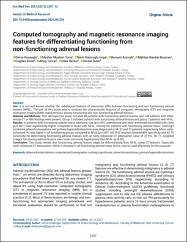| dc.contributor.author | Köseoğlu, Derya | |
| dc.contributor.author | Tuna, Mazhar Müslüm | |
| dc.contributor.author | Imga, Narin Nasiroglu | |
| dc.contributor.author | Ayçiçek, Bercem | |
| dc.contributor.author | Başaran, Mehtap Navdar | |
| dc.contributor.author | Şenel, Çağdaş | |
| dc.contributor.author | Tuncel, Altuğ | |
| dc.contributor.author | Berker, Dilek | |
| dc.contributor.author | Güler, Serdar | |
| dc.date.accessioned | 2022-12-14T08:38:45Z | |
| dc.date.available | 2022-12-14T08:38:45Z | |
| dc.date.issued | 2021 | en_US |
| dc.identifier.issn | 2636-7688 | |
| dc.identifier.uri | https://doi.org/10.5455/annalsmedres.2021.03.276 | |
| dc.identifier.uri | https://hdl.handle.net/20.500.12462/12732 | |
| dc.description | Şenel, Çağdaş (Balikesir Author) | en_US |
| dc.description.abstract | Aim: It is not well known whether the radiological features of adenomas differ between functioning and non-functioning adrenal
lesions (NFAL). The aim of this study was to evaluate the characteristic features of computed tomography (CT) and magnetic
resonance imaging (MRI) characteristics among functioning and non-functioning adrenal lesions.
Material and Methods: This retrospective study included 89 patients with functioning adrenal lesions and 148 patients with NFAL,
whose CT or MRI findings were present. Group 1 included patients with functioning adrenal lesions and group 2 patients with NFAL.
Results: In patients with functioning adrenal mass, adenoma size (p:0.001), unenhanced and early-enhanced Hounsfield units (HU)
(p<0.001) were significantly higher compared to those with NFAL. Among the patients with functioning adrenal mass; Cushing’s
syndrome, pheochromocytoma and primary hyperaldosteronism were diagnosed in 34, 32 and 23 patients, respectively. Mean earlyenhanced HU was higher in all functioning groups compared to NFAL (p<0.001, all). ROC analysis showed 80% specificity and 82.7%
sensitivity for determining functioning adrenal masses with an early-enhanced CT attenuation value of 27 HU. On T1-weighted
images functioning adrenal lesions were more commonly hypointense than NFAL (p=0.02).
Conclusion: This study reveals that functioning adrenal lesions might be differentiating from NFAL using CT features. Especially
early-enhanced CT attenuation, which is elevated in all functioning adrenal mass forms, may be used effectively for this purpose. | en_US |
| dc.language.iso | eng | en_US |
| dc.publisher | İnönü Üniversitesi Tıp Fakültesi | en_US |
| dc.relation.isversionof | 10.5455/annalsmedres.2021.03.276 | en_US |
| dc.rights | info:eu-repo/semantics/openAccess | en_US |
| dc.rights | Attribution-NonCommercial-NoDerivs 3.0 United States | * |
| dc.rights.uri | http://creativecommons.org/licenses/by-nc-nd/3.0/us/ | * |
| dc.subject | Adrenal Incidentaloma | en_US |
| dc.subject | Computerized Tomography | en_US |
| dc.subject | Cushing’s Syndrome | en_US |
| dc.subject | Pheochromocytoma | en_US |
| dc.subject | Primary Hyperaldosteronism | en_US |
| dc.title | Computed tomography and magnetic resonance imaging features for differentiating functioning from non-functioning adrenal lesions | en_US |
| dc.type | article | en_US |
| dc.relation.journal | Annals of Medical Research | en_US |
| dc.contributor.department | Tıp Fakültesi | en_US |
| dc.contributor.authorID | 0000-0002-4030-002X | en_US |
| dc.identifier.volume | 28 | en_US |
| dc.identifier.issue | 12 | en_US |
| dc.identifier.startpage | 2207 | en_US |
| dc.identifier.endpage | 2212 | en_US |
| dc.relation.publicationcategory | Makale - Ulusal Hakemli Dergi - Kurum Öğretim Elemanı | en_US |




















